Table of Contents
- Introduction
- Basic Solving Stragegies
- Example basic puzzle
- More advanced example based on weekly 24
- More advanced example based on weekly 28
- More advanced example based on weekly 74
- A daily (#1271) is easier than it looks
- More advanced example based on weekly 183
Killer Sudoku Solving Strategies
There are three basic methods used to solving killer sudoku puzzles. The first is to use the strategies for solving regular sudoku puzzles. The second is to consider the different ways that a sum can be created. The third is to consider the total value of a region. Here we outline the basic strategies and then show how they are applied in a sample puzzle. At a later date we will post more complex strategies. (The Terminology used on this page is defined on the rules page.)Basic Solving Strategies
The following are the basic rules used to solve killer sudokus.- Rule of 1
- This comes directly from the definition of sudoku. No region can contain any duplicate digits. In a sudoku region each digit appears exactly once. For example, if a digit appears in a row, it cannot be in any other cell in the row. Likewise, each digit can appear in a cage only once. If a digit is in a cage, it cannot appear in that cage again.
- Rule of Necessity
- This rule can be applied to sudoku regions (i.e., row, column, or nonet) or to a cage. In the former case, each region must contain all the digits one to nine. Thus, if all the digits but one appear in a row, the missing digit must appear in the empty cell.
- Rule of 45
- Each sudoku region (i.e., row, column, or nonet) contains the digits one through nine. Thus, each sudoku region has a total value of 45. If S is the sum of all the cages contained entirely in a region, then the cells not covered must sum to 45-S.
- Rule of K
- The Rule-of-k is an extension of the Rule-of-1. If there are k cells contained entirely in a region that contain exactly k different possible values, then no other cell in that region can contain any of those k values.
- Sum Elimination
- This strategy examines the different possible ways of making the
sum of a cage. Reducing the number of different possible ways of
making a sum, can often lead to a potential solution. There are
many ways of reducing the number of sums. For example, if a 2-cage
has a total of 3, 4, 16, or 17 there is only one combination of values
that can be used. (3=2+1, 4=3+1, 16=9+7, and 17=9+8.) 3-cages with
only 1 combination are: 6=1+2+3, 7=1+2+4, 23=9+8+6, 24=9+8+7. The sum
calculator found in the online player page can
be very handy.
| Rule of 45 | 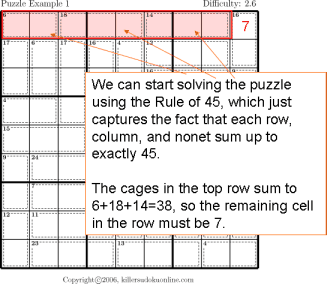 |
|
| Rule of necessity | 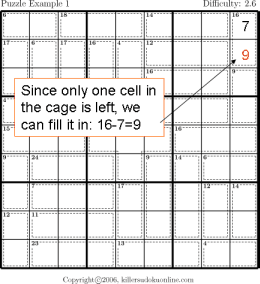 |
|
| Rule of 1 |  |
|
| Unique Sums |  |
|
| Rule of K | 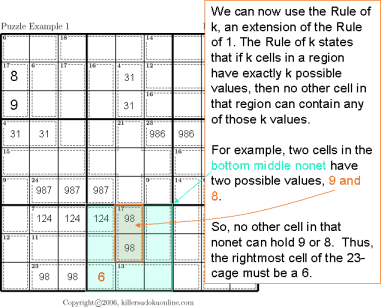 |
|
| Rule of K Limited possible sums |
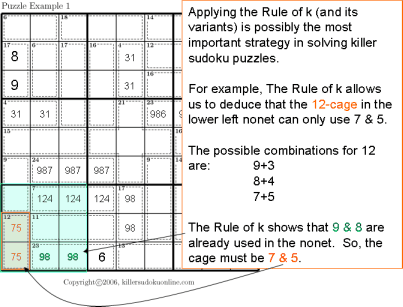 |
|
| Rule of necessity | 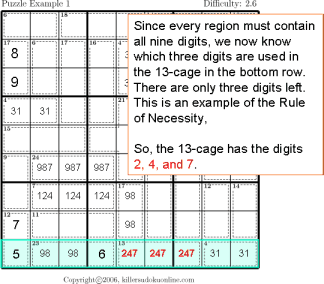 |
|
| Limited Possible Sums | 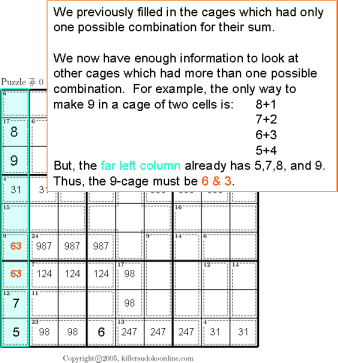 |
|
| Rule of K | 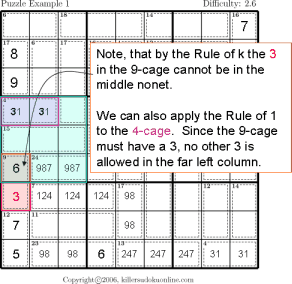 |
|
| Limited Possible Sums Rule of 1 Rule of K |
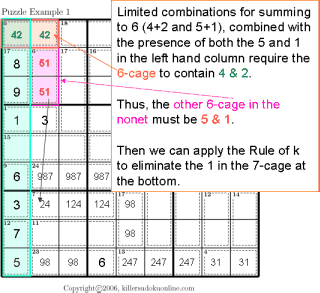 |
|
| Rule of Necessity Rule of 1 All Possible Sums |
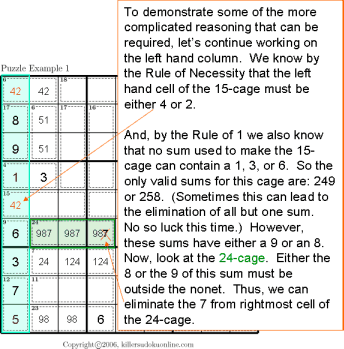 |
|
| Rule of Necessity Limited possible sums |
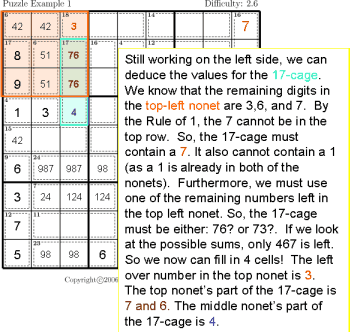 |
|
| Rule of K Rule of 1 Limited Possible Sums |
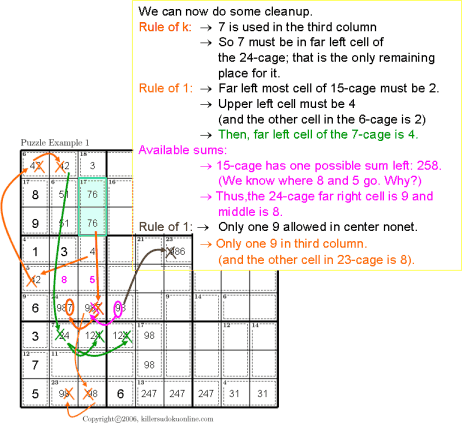 |
|
| Remaining sum Rule of 1 Rule of K Rule of necessity |
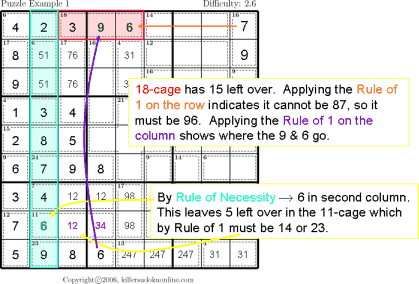 |
|
| Sum Elimination | 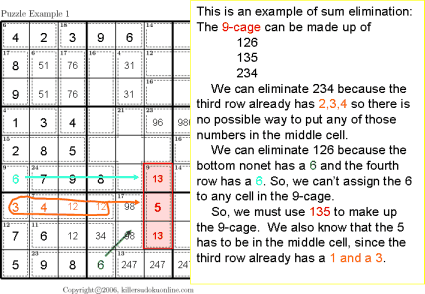 |
|
| Sum elimination Rule of 1 |
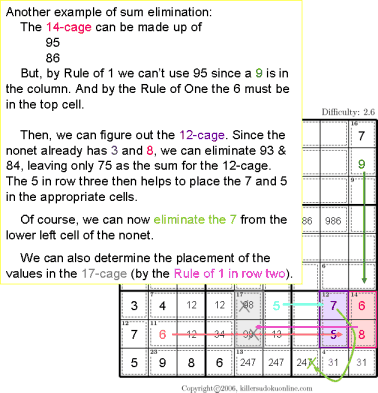 |
|
| Range of Totals Sum Elimination |
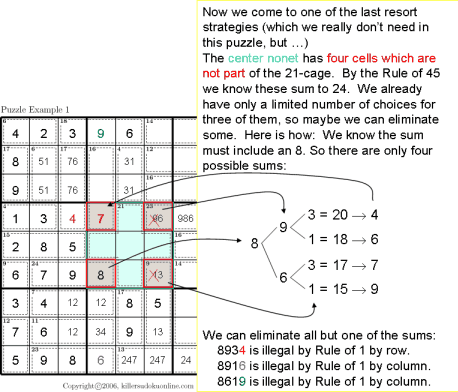 |
|
| Rule of 1 Rule of necessity Remaining Sum |
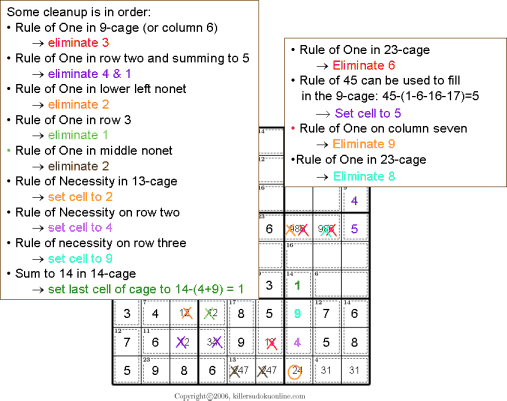 |
|
| Limited possible sums Rule of 1 Rule of necessity |
 |
|
| Rule of necessity Rule of 1 |
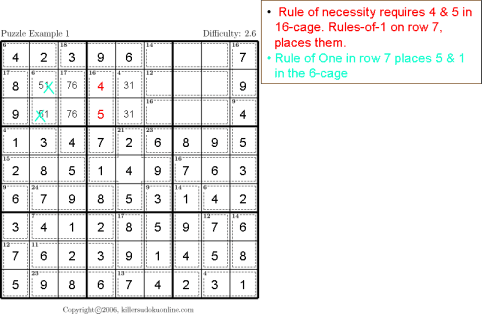 |










